Key takeaways:
- Music serves as a universal language that can express complex emotions better than words, connecting listeners to their past and present feelings.
- Emotional expression in music fosters a genuine connection between artists and listeners, promoting healing and understanding through shared experiences.
- Techniques such as dynamics, lyrical imagery, and instrument choice significantly enhance the emotional impact of a musical piece.
- Personal experiences and vivid imagery in songwriting can resonate deeply with audiences, invoking powerful memories and emotions.
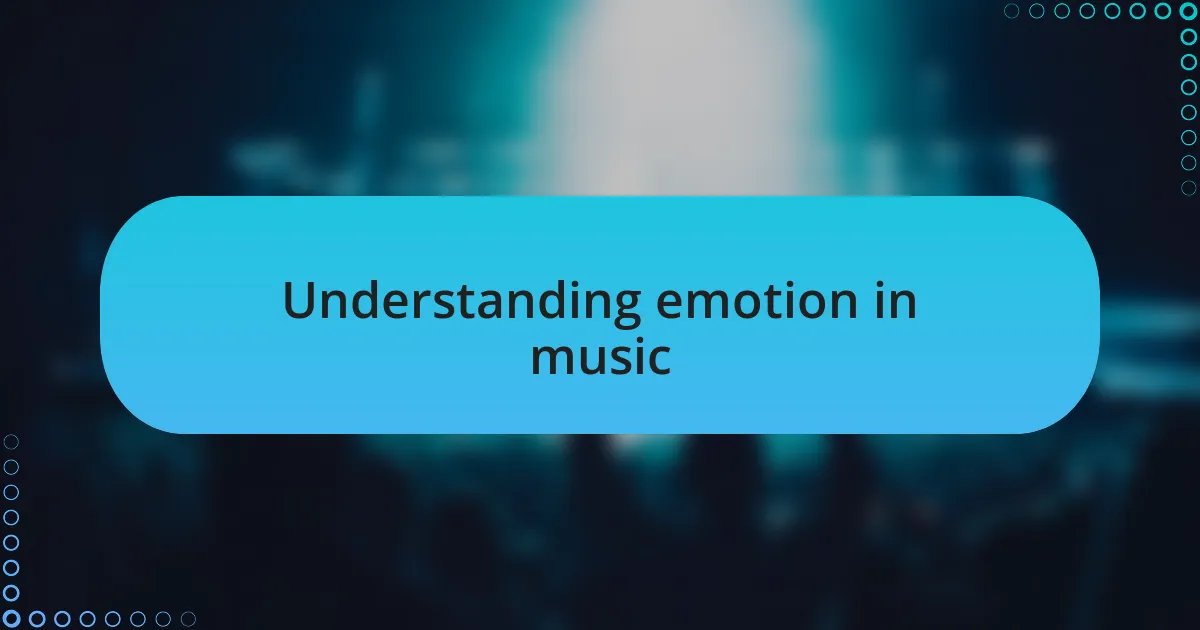
Understanding emotion in music
Music is a universal language that resonates deeply within us, allowing us to tap into a range of emotions. I remember the first time I heard a certain melody that instantly transported me to a moment of pure joy—these experiences remind me that music can encapsulate feelings that words often fail to express. Have you ever found yourself getting lost in a song, feeling every beat as if it were narrating your own life story?
Understanding emotion in music goes beyond just notes and rhythms; it involves recognizing how different musical elements evoke specific feelings. For instance, a minor key might give you that melancholic vibe, while a major key often lifts us up. I once played a sad piece on the piano, and afterward, I felt a weight lift off my shoulders—it’s fascinating how music can serve as both a mirror to our feelings and a release for our emotional burdens.
Think about your favorite song. What emotions does it stir within you? For me, listening to a powerful ballad can bring a sense of nostalgia, stirring memories and feelings I hadn’t thought about in years. Music has a profound ability to connect us to our past and help navigate our present emotions, acting as both an emotional guide and a companion.
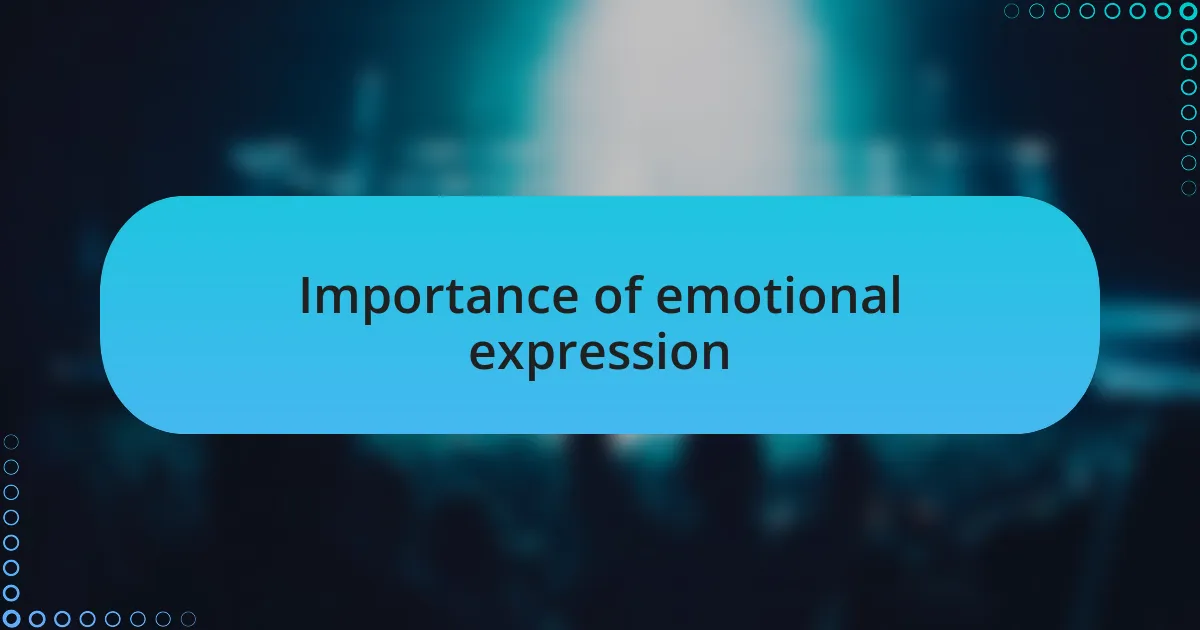
Importance of emotional expression
Expressing emotions through music is crucial because it creates a genuine connection between the artist and the listener. I’ve often felt a surge of energy when a band pours their heart into a live performance, making the audience feel united in shared emotions. Have you ever found yourself swaying with strangers, all of you united under the weight of the same bittersweet melody?
Emotional expression also allows musicians to explore their innermost feelings, turning pain or joy into creativity. I remember writing a song during a particularly tough time in my life. As I poured my feelings into the lyrics and melody, it felt like therapy—a cathartic release that not only helped me heal but also resonated with others who listened. Isn’t it amazing how sharing vulnerability through music can foster understanding and support?
Additionally, emotional expression in music can motivate healing and growth. When I hear a song that speaks directly to my struggles, it often encourages me to embrace my journey rather than shy away from it. This emotional authenticity not only enriches the musical experience but also empowers listeners to confront their feelings, turning music into a powerful tool for resilience and connection.
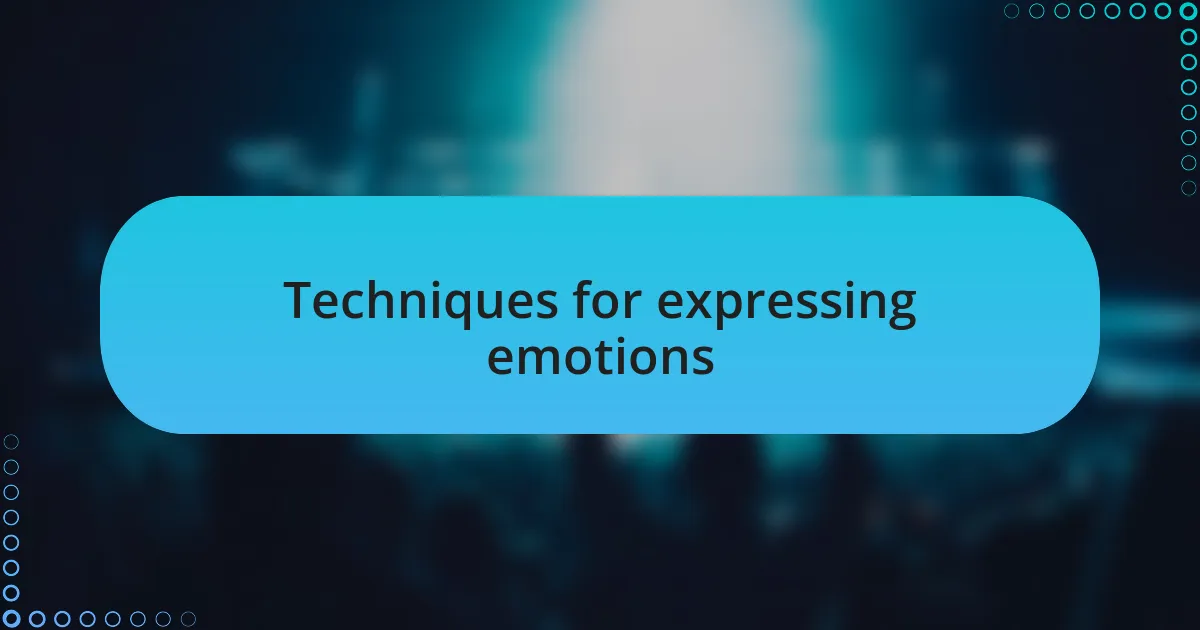
Techniques for expressing emotions
When it comes to expressing emotions in music, one of the effective techniques I often use is dynamics—the variation of volume and intensity. I’ve experienced moments where a soft, whispering verse gives way to an explosive chorus, creating a sharp contrast that amplifies the emotion in the song. Have you ever felt the sudden rush of emotion when the music swells, pulling you into the experience?
Another powerful method is through lyrical imagery. Crafting vivid, relatable images in my lyrics helps convey deep feelings that resonate with listeners. I recall writing a verse about watching a sunset, using it as a metaphor for lost love. The imagery not only painted a picture but also stirred emotions in those who listened, allowing them to connect their own experiences with the song.
Then there’s the aspect of instrumentation, which can dramatically shift the emotional landscape of a piece. I remember experimenting with different instruments—like adding a cello to a track. The deep, rich tones of the cello brought an unexpected warmth and melancholy that words alone couldn’t achieve. Have you ever found yourself moved by the sound of a single instrument, feeling it echo your own emotions? It’s fascinating how a simple arrangement can evoke such profound feelings.
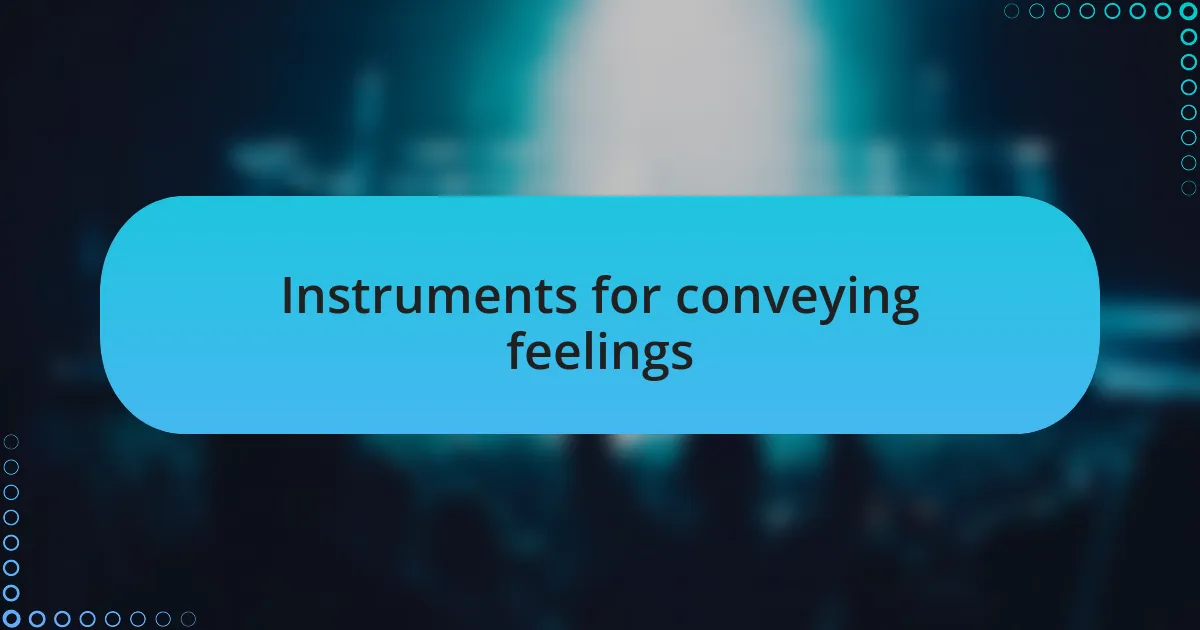
Instruments for conveying feelings
In my experience, the choice of instrument can evoke a distinct emotional response. For instance, I once incorporated a haunting piano melody into a song about nostalgia. The delicate notes seemed to linger in the air, tapping into a memory I thought long forgotten. Have you ever heard a piano piece that made you feel as if it was narrating your own story? There’s something truly magical about how certain instruments can resonate with our inner feelings.
Another fascinating aspect is the use of strings, like violins or cellos, which can add layers to emotional expression. One time, during a rehearsal, I introduced a string arrangement into an upbeat track. The lush, sweeping sounds transformed the song, imbuing it with a bittersweet texture that made listeners sway with a sense of yearning. It’s moments like these that make me wonder how a single instrument can shift the mood entirely, isn’t it remarkable?
Percussion instruments also play a vital role in conveying emotions, often leaving an impact that’s hard to ignore. I recall performing a song where I used hand drums to create an urgent, pulsing rhythm that pushed the energy forward. The heartbeat-like quality not only thrilled the audience but also connected us on a deeper level—an experience I could feel in my bones. Have you felt that undeniable pull from a well-placed drum beat, driving the emotion home? It’s an exciting reminder of how rhythm can shape our emotional journey in music.
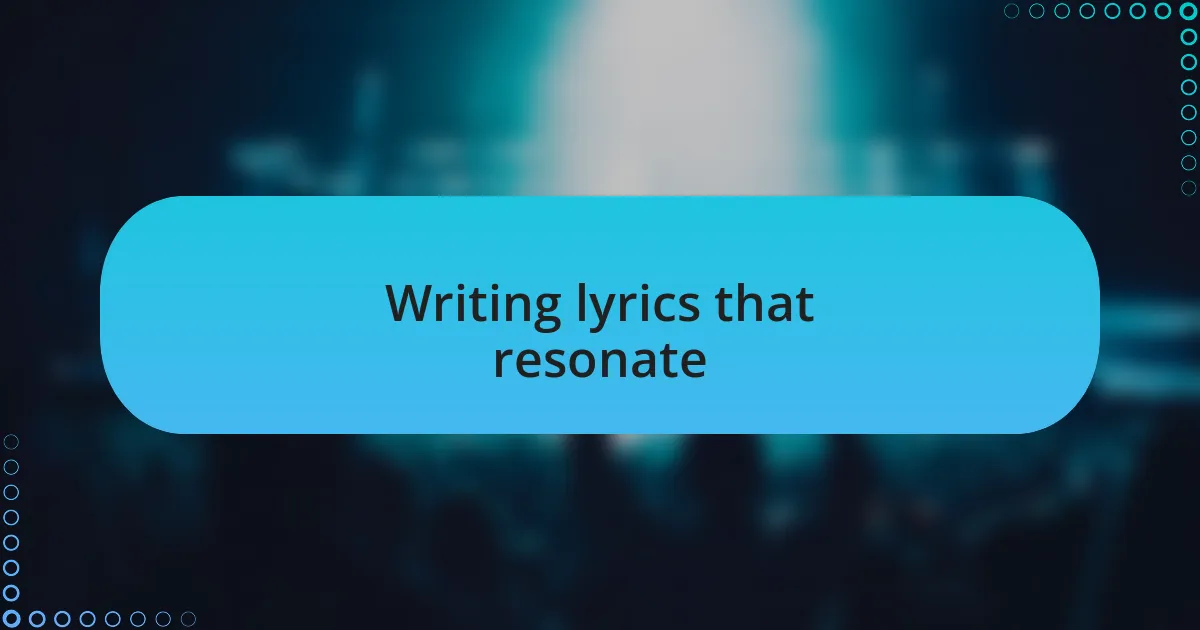
Writing lyrics that resonate
When I sit down to write lyrics, I focus on personal experiences that echo universal themes. I remember crafting a song about heartbreak, drawing from a relationship I thought was everlasting. By weaving in specific details, like the smell of rain on pavement during our long walks, listeners could almost feel the weight of that sadness as if it were their own. Doesn’t it strike you how a few carefully chosen words can bring back vivid memories?
Imagery plays a crucial role in making lyrics resonate emotionally. I once penned a verse about the feeling of standing at the edge of a cliff, feeling both terrified and exhilarated. That visceral image allowed listeners to place themselves in a similar situation, inviting them to confront their own fears and hopes. Have you ever found yourself mesmerized by a line that painted such a clear picture in your mind that it felt real?
Moreover, the structure of the lyrics can enhance their emotional impact. In a recent song, I decided to use a repetitive chorus that mimicked the feeling of being trapped in a cycle of thoughts. As I performed it, I watched as faces in the audience shifted from confusion to understanding. It’s fascinating how the musical phrasing and lyrical repetition can create a sense of urgency—have you noticed how some songs persistently linger in your mind, resonating with your emotions long after you’ve heard them?
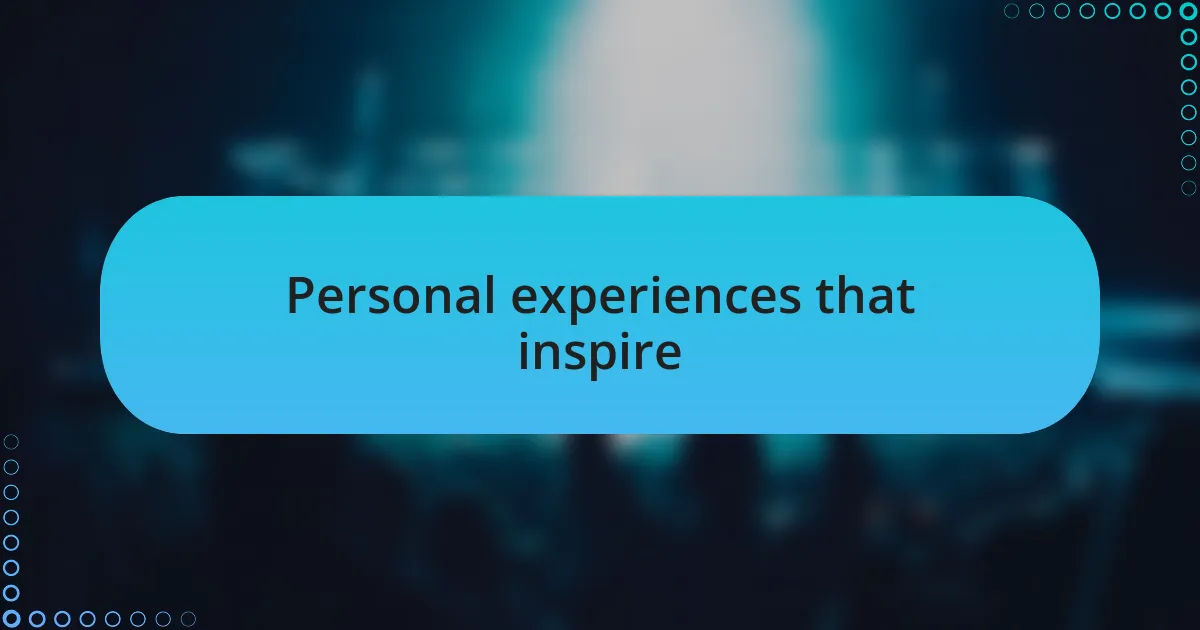
Personal experiences that inspire
Reflecting on my personal journey, one experience stands out vividly. During a particularly challenging time, I found solace in writing a song about overcoming anxiety. I captured the feeling of standing in a crowded room, heart racing and palms sweating, but I also infused elements of hope. Isn’t it interesting how sharing a struggle can bind us together in understanding?
One of my most cherished songs arose from a long, quiet drive through the countryside after a family loss. As I watched the fields rush by, I felt a swell of emotions; I wrote about the bittersweet memories of laughter mixed with tears. In moments like these, I learn that music can serve as a comforting blanket, stitching together fragmented emotions. Have you ever had a moment when a simple melody brought back a flood of feelings?
I also remember the exhilarating rush after performing a song based on a joyful memory with friends. I wrote about our carefree days spent at the beach, capturing not just the thrill of waves crashing but the warmth of friendships that felt eternal. Every time I play it live, I see smiles, and it reminds me that sharing joy can amplify our collective happiness. Isn’t it incredible how music allows us to reconnect with those cherished moments?